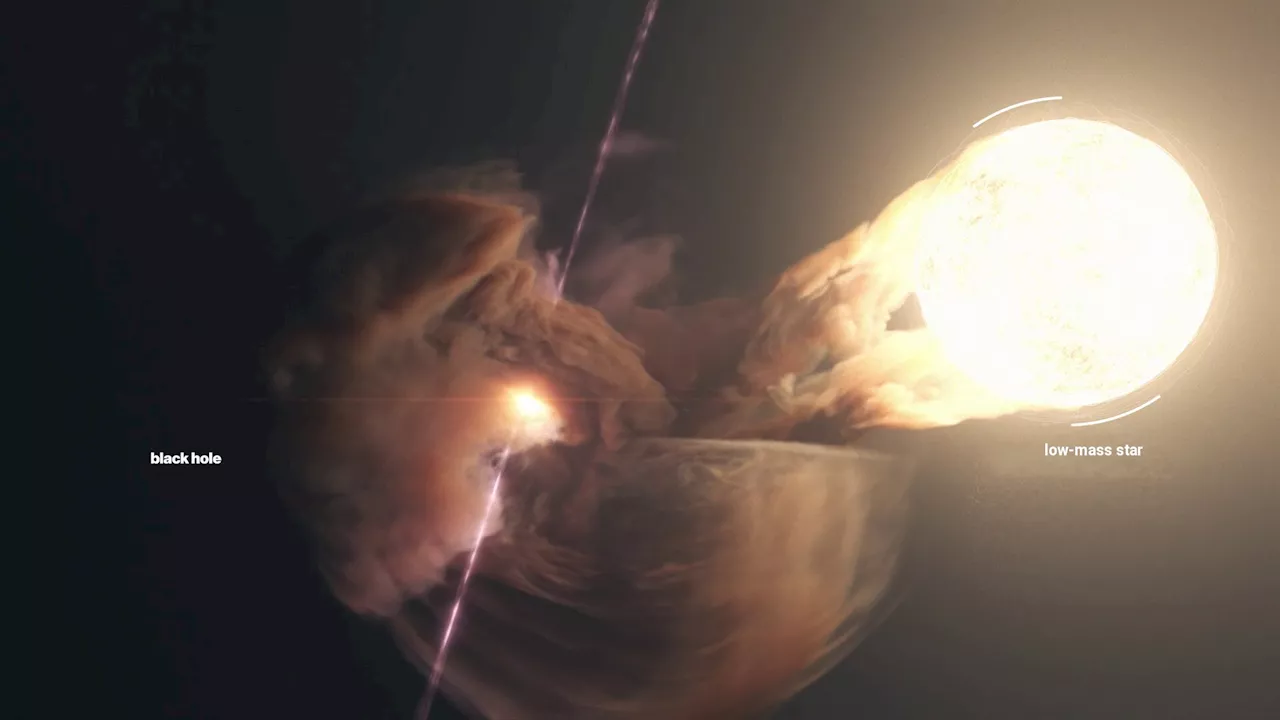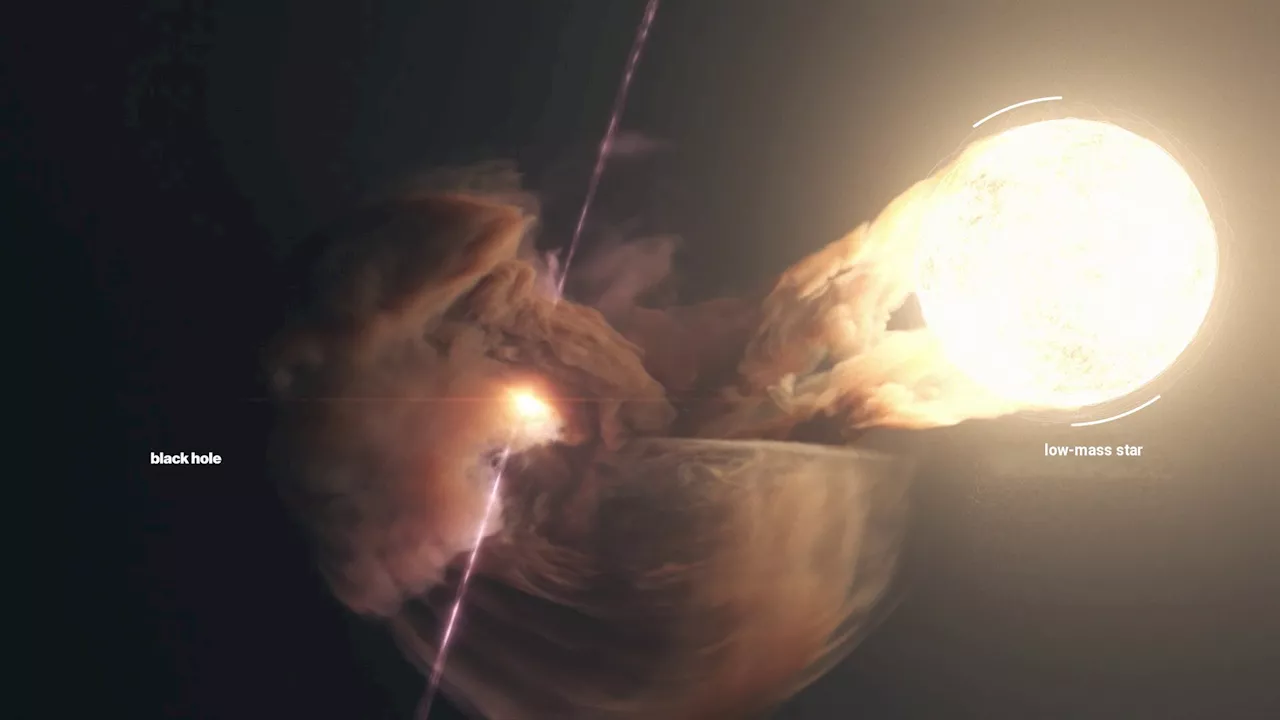A new study suggests that low-mass microquasars, stellar-mass black holes in our galaxy, can produce high-energy cosmic rays, potentially solving part of the mystery surrounding their origin.
The Earth is bathed in high-energy particles. Known as cosmic rays, most of them are. Fortunately, the atmosphere protects us from any significant harm, though the particles can strike with so much energy that they create a shower of lower energy particles that do reach Earth’s surface. That’s actually how we can detect most cosmic rays.
Not all stellar-mass black holes are microquasars. Regular quasars create jets by capturing material from the galaxy surrounding them, but microquasars need a companion star to pull material from. The amount of energy a microquasar can produce depends on the available material, so microquasars are often categorized by the mass of their companion star. For high-mass microquasars the black hole’s companion is several times the mass of the Sun, providing plenty of material to accelerate.
COSMIC RAYS MICROQUASARS GAMMA RAYS BLACK HOLES SUPERNOVAE
United States Latest News, United States Headlines
Similar News:You can also read news stories similar to this one that we have collected from other news sources.
 Low-Mass Microquasars Found to be Efficient Particle AcceleratorsFor the first time, researchers have found evidence that even microquasars containing a low-mass star can accelerate particles efficiently. This discovery, based on 16 years of data from NASA's Fermi satellite, has significant implications for our understanding of the abundance of gamma rays in the universe.
Low-Mass Microquasars Found to be Efficient Particle AcceleratorsFor the first time, researchers have found evidence that even microquasars containing a low-mass star can accelerate particles efficiently. This discovery, based on 16 years of data from NASA's Fermi satellite, has significant implications for our understanding of the abundance of gamma rays in the universe.
Read more »
 Low-Mass Microquasars: A Potential Source of High-Energy Cosmic RaysA new study suggests that low-mass microquasars, stellar-mass black holes with companion stars, may be contributing to the high-energy cosmic rays detected on Earth.
Low-Mass Microquasars: A Potential Source of High-Energy Cosmic RaysA new study suggests that low-mass microquasars, stellar-mass black holes with companion stars, may be contributing to the high-energy cosmic rays detected on Earth.
Read more »
 Gaia Mission Uncovers Giant Exoplanet and Brown Dwarf Orbiting Low-Mass StarsUsing its astrometry capabilities, ESA's Gaia spacecraft has detected a massive exoplanet and a brown dwarf orbiting low-mass stars. This discovery, published today, challenges existing theories of planet formation and highlights Gaia's potential to uncover vast numbers of new exoplanets and brown dwarfs in the future.
Gaia Mission Uncovers Giant Exoplanet and Brown Dwarf Orbiting Low-Mass StarsUsing its astrometry capabilities, ESA's Gaia spacecraft has detected a massive exoplanet and a brown dwarf orbiting low-mass stars. This discovery, published today, challenges existing theories of planet formation and highlights Gaia's potential to uncover vast numbers of new exoplanets and brown dwarfs in the future.
Read more »
 Eagle Pass sees low temps, low crossing numbers ahead of inaugurationEAGLE PASS, Texas - On the eve of President-elect Trump's inauguration, the border town of Eagle Pass is bracing for freezing temperatures.Some experts predicte
Eagle Pass sees low temps, low crossing numbers ahead of inaugurationEAGLE PASS, Texas - On the eve of President-elect Trump's inauguration, the border town of Eagle Pass is bracing for freezing temperatures.Some experts predicte
Read more »
 What's Your Favorite Low-Stakes, Low-Conflict Comfort Watch?This article invites readers to share their favorite movies that offer a relaxing and enjoyable viewing experience with minimal conflict or tension. It highlights the appeal of comfort watches, particularly in times of stress, and encourages discussion about what makes a film so soothing and enjoyable.
What's Your Favorite Low-Stakes, Low-Conflict Comfort Watch?This article invites readers to share their favorite movies that offer a relaxing and enjoyable viewing experience with minimal conflict or tension. It highlights the appeal of comfort watches, particularly in times of stress, and encourages discussion about what makes a film so soothing and enjoyable.
Read more »
 BCL6 Protein May Hold Key to Maintaining Muscle MassA new study in mice suggests that the protein B cell lymphoma 6 (BCL6) plays a crucial role in maintaining healthy muscle mass. Mice lacking BCL6 exhibited significantly reduced muscle mass and function, while increasing BCL6 levels reversed these losses. The research also indicates that fasting may reduce BCL6 levels in muscles, potentially contributing to muscle wasting. These findings could pave the way for therapies targeting BCL6 to combat muscle-wasting diseases.
BCL6 Protein May Hold Key to Maintaining Muscle MassA new study in mice suggests that the protein B cell lymphoma 6 (BCL6) plays a crucial role in maintaining healthy muscle mass. Mice lacking BCL6 exhibited significantly reduced muscle mass and function, while increasing BCL6 levels reversed these losses. The research also indicates that fasting may reduce BCL6 levels in muscles, potentially contributing to muscle wasting. These findings could pave the way for therapies targeting BCL6 to combat muscle-wasting diseases.
Read more »
